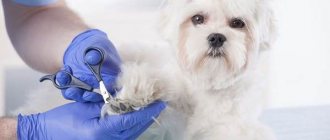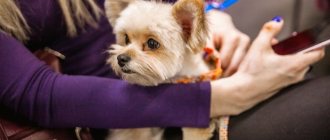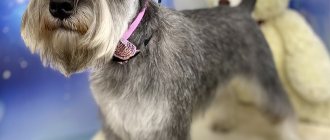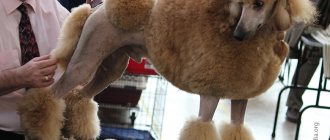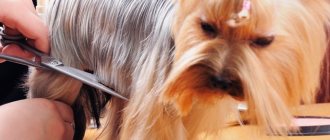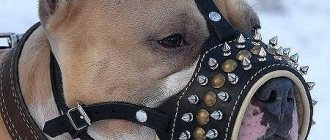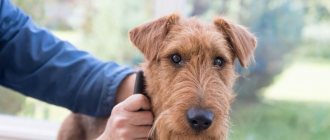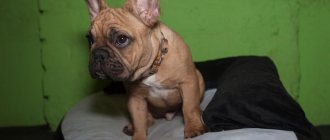What is grooming?
Initially, the term defined the animal’s self-care for itself. In the modern world, the word has received a different interpretation, since man took upon himself all the main concerns for those whom he managed to tame. Thus, grooming can be defined as a set of caring activities. Moreover, many people strongly associate the term exclusively with caring for a dog’s coat. This is wrong.
It includes two types of procedures:
- hygienic . This includes hair care, which consists of bathing, drying, combing, trimming and removing tangles. But at the same time, this also includes caring for the dog’s eyes, ears and teeth. Periodic hygiene is also part of grooming. Removing ticks that have already burrowed into the dog and treating wounds are a type of grooming;
- aesthetic . From the name it becomes clear that the procedures are aimed at improving the dog’s appearance - curly hair cutting, teeth whitening, tattooing, exhibition preparation.
Dog owners should remember that grooming is necessary for everyone.
But to what extent and in what form is up to the owner to decide.
Basics: How to Learn Grooming
So, the legal aspects are over. But if you plan to groom animals yourself, you will have to undergo grooming training. But where and how to do this?
You have several options:
- Grooming courses. Twenty to thirty hours of training - and the professional groomer is ready to work! For those who cannot attend classes, online courses are provided. But it’s better, of course, to study “live”, with the opportunity to practice.
- Grooming school. Essentially the same as courses, but can offer more extensive programs in different areas of study with the involvement of specialists from related fields.
- Groomer's apprentice. Sometimes professional groomers hire assistants who are paid little, but who are taught the intricacies of the job in practice.
- Self-learning. Books, webinars, trainings, etc. Allows you to acquire a strong theoretical base that can be applied in practice.
Whatever type of training you choose, remember: a good groomer is one who is constantly improving. Therefore, in the future you will have to invest in additional education.
Description and features
In addition to haircuts, dog grooming includes the following procedures:
- cleaning or rinsing the ears;
- trimming claws, sharpening them and covering them with protective and decorative means, if desired;
- washing the eyes with antiseptic agents;
- clearing the sinuses;
- washing with disinfectants and drying;
- preventive treatment against the possibility of infection by parasites, ampoules are usually used on the withers;
- cleansing the anal glands;
- detangling wool if necessary;
- teeth cleaning.
That is, the main feature and main difference of this procedure is that, once on the grooming table , the dog will receive a full range of care, in other words, grooming salons are similar to beauty salons and differ from a simple haircut procedure in the same way as a beauty salon from a hairdresser's .
In addition to the above procedures, which are always included in grooming, each salon also offers something else, for example, the use of dog grooming spray , which allows you to “maintain” the volume and shape of the animal’s “hairstyle” for a long time, by securing the roots of the guard hair in a certain position
Permits for a grooming salon
This type of activity such as grooming is not strictly regulated in Russia. This means that you will not need to buy a grooming license. Moreover, there are no educational requirements for the employees of such a company (but in order for clients to be satisfied, you must have a professional groomer working for you who has completed at least a course).
To register as an individual entrepreneur and register with the tax authorities, you will need to collect the following package of documents:
- photocopies of TIN and passport (stitched);
- application (form P21001);
- receipt of payment of state duty upon registration of individual entrepreneurs;
- application in duplicate in form No. 26.2-1 for a simplified taxation system (optional).
Documents can be submitted in person, by mail or through an intermediary (in this case, the signature on the application is certified by a notary). When filling out documents for registration of an individual entrepreneur, you will need to indicate code 93.05 OKVED and code 018 317 OKUDN - provision of other personal services and grooming of pets, respectively.
Also, do not forget that when renting premises you will need permits from the State Fire Inspectorate.
Types of grooming
It would seem that everything is clear with care procedures. However, we can distinguish types of grooming:
- hygienic – all measures that are necessary to maintain the health of the animal;
- professional - this type is resorted to under certain circumstances: during preparation for an exhibition, creating an image for a photo shoot, etc. In this case, you cannot do without a professional; it is better if he works only with one or two breeds. Such specialists will be able to cut the dog’s hair, emphasizing its natural beauty and grace, and bleach the fur with special compounds without creating a danger to the pet’s health;
- creative _ Most often, such a specialist is approached by those who want to create a unique and fashionable image for their dog.
If everything is clear with the frequency of hygienic grooming - such procedures are carried out at least once a week, then with a haircut the issue is complex. It depends on the condition of the coat, its length and tendency to form tangles. In this matter, it is better to trust a specialist who can select special equipment that you can use at home between trips to the salon.
How often can you cut your hair?
There is no definite answer to this question; the frequency of dog grooming is carried out when it is needed. That is, if an animal’s fur has grown in a month, there is absolutely no reason to wait another couple of months, during which the animal will turn into an overgrown porcupine, just because some practical care guide says about the need for haircuts every three months.
The dog needs to be cut as often as necessary, for example, extra show class poodles are cut at least once a week, and sometimes twice. Of course, the animal does not grow overgrown in such a time; we are talking about maintaining the existing haircut “at the level”.
At what age and how to accustom a dog to grooming
It is better to teach hygienic treatment from early childhood, that is, even before separation from the mother. The baby should get used to cleaning his ears and eyes, trimming his claws and combing his fur. Otherwise, all these manipulations will result in extreme stress and defensive aggression, which can lead to injury for the owner and groomer.
For the first time, puppies are cut no earlier than 4-6 months. The exact time depends on the length and capriciousness of the coat. Animals prone to matting can begin to be trimmed as early as 3 months.
You should get accustomed to skincare manipulations in stages:
- Combing. Gently move the comb over the fur until the first signs of dissatisfaction appear. Gradually increase the duration of combing and the treatment area. Ultimately, the dog must endure the treatment of the most sensitive areas: the belly, tail and ears.
- Introducing scissors. Let your pet sniff the tool and try to trim the ends of the hairs with it.
- Demonstration of a razor machine. Use it without plugging it in or without batteries. After getting used to the sensations, add sound, and then direct processing.
During training, be sure to reward your four-legged pet with praise and treats. Don't force things and act based on his reaction. Shy animals may take a little longer.
Salon or home conditions?
Many owners think about this question, giving themselves many reasons for and against. If you decide to use the services of a professional groomer, then you don’t have to go or go to the salon. In the modern world, a specialist can come directly to your home to “beautify” your dog in a familiar environment. But even having a groomer come home has its downsides:
- Any dog perceives its home as a territory that needs its protection. A stranger may cause a negative reaction;
- in a home environment it is difficult to create the same workplace that a master has in a salon. This includes washing the dog in a special bath, and a convenient table for grooming with fixation of certain positions;
- need for cleaning.
Of course, there remains the possibility of caring for the dog yourself. If a show career or a hair-to-hair look is not your dog's thing, you can cut it yourself. Well, regular grooming shouldn’t cause any problems at all. If cutting a haircut is difficult, visit the salon and watch how the hairdresser does it.
Salon grooming is distinguished by quality and convenience. In trusted places with an impeccable reputation, there are specialists who can persuade even the most intractable “client” to have their unloved nails trimmed. Of course, such professional services are not cheap.
Grooming salon: choosing a work model
The very first thing you will have to decide is the scale of your future enterprise. They depend not only on the size of your ambitions and start-up capital, but also on the size of the population in the area in which you plan to work.
If you live in a village or small town, then opening a grooming salon means working at a loss. It is estimated that to achieve profitability levels, an average of 5 people need to come to you every day. Therefore, you have two options: either you open a salon in a city with a large population, or you will offer grooming services at home (with a visit to the client), which will expand the client’s habitat.
If there are no problems with potential visitors, then you should decide on the size of the enterprise. You can either work independently or hire help. You can also buy a ready-made operating business model, that is, invest in a grooming salon franchise: this approach will facilitate the first stage of opening your own business, but in the future you will have to “play by the rules” of the chosen franchise.
So, when you have decided how many people you will have under your command, you will have to resolve the legal issues related to opening a salon (if, of course, you are going to act within the legal framework and pay taxes). You will have to choose between registering an LLC and an individual entrepreneur.
IP is your option if:
- you plan to work alone or with a minimum of employees;
- you will independently manage the salon;
- you are ready to bear full financial responsibility for the company’s obligations;
- you're not going to attract investors.
An individual entrepreneur is a good choice for those who do not have a large start-up capital and who are going to delve into all the issues related to both grooming and accounting.
Advantages of IP:
- simple and fast registration procedure;
- simplified financial discipline (cash management);
- you can do without an accountant;
- lower tax burden than in an LLC;
- The company is easy to liquidate.
If you are planning to launch your own chain of animal grooming salons, then your choice is LLC.
Is it possible to work without opening an LLC or individual entrepreneur? It is possible, but it is illegal (Article 171 of the Criminal Code of the Russian Federation) and entails difficulties in finding premises for rent, and it will also be impossible to find business partners. Therefore, it is better to open an individual entrepreneur, especially since it is not as difficult as it seems.
Why does a dog need a haircut in a salon?
- Neat appearance;
- Cleaning wool;
- Ensuring proper breathing of the skin, getting rid of parasites;
- Prevention of tangles, inflammation and skin irritation;
- Prevention of ear and eye diseases;
- Prevention of ingrown nails and diseases of small joints;
- Relief from fur in the house during shedding;
- Adding harmony to the image.
It is important to accustom your pet to grooming from the first months of life.
Take a walk before the procedure, play, let the dog be in a good mood. It is better to postpone eating and do not feed the dog before grooming.
The Grumik pet salon holds master classes for dog owners, where owners receive knowledge that allows them to care for their dogs and cats. Hair trimming, ear cleaning, claw trimming is an excellent program. After completing this program, the owner will not only be able to maintain the appearance of the pet from haircut to haircut, but will also learn how to do fashionable hairstyles for his pet.
Hair trimming is necessary for decorative breeds: West Highland White Terrier, Yorkshire Terrier, Spitz, Spaniel, Maltese and many others with thick, long hair. In the absence of proper care, the dog becomes unkempt, the hair falls off, tangles appear, which cause pain and discomfort to the pet.
How to accustom your pet to the procedure?
In order to accustom your miniature friend to a haircut, there are several simple rules:
- the earlier the better. The sooner you start accustoming your dog to grooming, the easier it will be for him to tolerate it;
- You should not force the dog or use violent methods - act gently, use reward methods;
- Accustom the puppy gradually, first show him the place. Let him get used to it, then try cutting it and see how he reacts;
- Try to carry out such procedures only when your pet is in a good mood, then reward him with a treat or a new toy. This way you will cement in his memory the pleasant sensations from the procedure;
- completely eliminate pain. If your pet is injured, reassure him and stop the procedure immediately. Postpone your haircut for a more convenient time
NOTE!
Do not punish your baby if he does not want to get his hair cut, and do not yell at him under any circumstances, otherwise you will only aggravate the situation and scare the dog.
What do you need to groom dogs at home?
Even if you regularly visit the salon, you need to know the main points about home grooming. You should not overpay for hygienic care; being able to perform manipulations is the responsibility of the dog owner.
Grooming Tools
At home you need to have:
- a comb with iron teeth, a slicker brush, a mitten with a silicone brush. The set of tools for combing depends on the pet's coat;
- scissors of different sizes with blunt tips so as not to injure the dog;
- high-quality sharp nail clipper, selected according to the diameter of the animal’s claws;
- device for cutting tangles. This type of tangle cutter is also useful in cases where the dog picks up a burdock;
- cotton pads, napkins and other material that will be on hand for treating eyes and ears;
- specialized sprays and lotions for hygiene;
- shampoo selected according to age, coat type and color. You can purchase dry shampoo or powder that allows you to clean your hair without water;
- toothpaste and brush, tartar remover.
Such a set of tools and tools should be at hand. After all, a dog can become dirty at any moment of the day or night.
Required Items
If you decide to trim your pet yourself, you will need:
- sharp hairdressing scissors;
- thick single-row metal comb;
- slicker;
- brushes and combs for routine care.
But that is not all. The place where the pet is cut is of great importance. After all, during the processing process he should feel comfortable, convenient and safe.
The best option is a standard height table or bar counter. The place for the procedure should be well lit and covered with a cloth or a special rug so that the dog’s legs do not move apart and he feels calm.
Types of haircuts
There are a huge number of dog breeds in the world, and types of haircuts have been developed designed to highlight the beauty and hide the dog’s shortcomings.
Types of haircuts:
- trimming - even cutting of the coat over the dog's body;
- stripping _ For breeds with hard coats that hardly shed. The “old” fur is plucked by a groomer. Stripping is carried out for schnauzers, terriers, huskies, etc.;
- Rolling is a subtype of stripping. Feature: dying fur is removed not at once, but gradually. This type of haircut is carried out once every two weeks;
- top note . Everyone knows a hairstyle with an elastic band or a hairpin, performed in the form of a ponytail on the head. A striking example is the Yorkshire Terrier;
- thinning _ Creates smooth transitions between long and short hair. For example, this technique is used when preparing for a cocker spaniel exhibition.
Preparing for an exhibition will require the groomer to have knowledge, skills and tools. It is quite difficult to perform these types of haircuts at home.
What breeds need
Most people mistakenly believe that grooming is only necessary for toy or show dogs. Indeed, a high-quality and correct haircut for a Yorkshire Terrier, Maltese or Shih Tzu that meets the requirements and rules of competitions can often only be done in a salon. But knowing what dog grooming is, owners begin to understand that many dog breeds need high-quality and regular care. In particular these are:
- Spaniel - needs a hygienic haircut, in which the hair is cut short: along the torso, paws, belly, tail and ears, and the hair of the anus is also trimmed. Some varieties of the breed, such as the American Cocker Spaniel, require a fashionable haircut, in which the ears are given the correct contour, and the hair on the paws is combed and trimmed into a neat skirt.
- For a long-haired Chihuahua, it is important to proportionally trim the hair on the back and sides, paws and ears, and trim the hair in the groin.
- Retrievers need a complex model haircut, in which transitions from the grooming tool should not be visible.
- The Chow Chow needs the coat to be evenly shortened throughout the body, and the fur on the paws to have a certain rounded shape. Often, Chow Chow owners prefer a model haircut like a lion, leaving a luxurious mane.
- Dogs with coarse hair, such as terriers, schnauzers, poodles, need to thin their coat using trimming and shredding.
Grooming for other breeds that do not require special haircuts consists of hygiene procedures and regular care.
Main stages of grooming
Care consists of several mandatory stages:
- Carefully comb the animal's fur. Everything that gets in the way is removed: tangles, dirt, old hairs, etc.
- A haircut. For a show dog, the type of haircut is selected according to the breed, styled according to the standard. For a pet with no prospects, any haircut can be performed.
- Hygienic treatment of eyes, ears and teeth.
- Nail trimming. Often this is the point that causes difficulties.
- Cleaning the anal glands.
- Water procedures. Washing the dog is done with special shampoos, without using human cosmetics.
- Dry thoroughly. At home they use a towel and a hairdryer, and in the salon there is a compressor.
General information
Dog grooming consists of two types of procedures:
In fact, absolutely every dog needs grooming.
Reasons for the need for grooming
The main reason to constantly groom your dog is to keep it clean. There are frequent cases of diseases in dogs associated with the ears, eyes, teeth, and skin. Most likely, these diseases are associated with non-compliance with the rules of caring for the animal. After all, a neat and clean dog is a priori healthy.
REFERENCE! When washing your dog, you must use special products for animals. Dog grooming cosmetics are available for sale.
Besides hygiene, the reason for the need for regular grooming is to ensure that the dog looks like it lives up to its pedigree. If you keep a pet with a long pedigree, you are simply obliged to do constant grooming, because why then would you buy a purebred dog? In addition, when a dog participates in competitions and exhibitions, it must also undergo regular haircuts and special care.
When to start grooming your pet
It is better to start grooming breeds with long hair, especially decorative ones, when they reach 3 months of age. If your dog develops tangles before this age, it’s worth starting even earlier. If the owner cannot cope with the task, it is better to contact the salon.
Painful combing of tangles at home can forever turn the dog away from such procedures.
It is better to start grooming and accustoming your puppy to it in a salon environment. If the owner does not have sufficient experience, cutting a baby's hair can result in injury, and cutting nails can result in blood poisoning.
How much do groomer services cost?
Prices for grooming for a toy terrier vary greatly depending on the region, range of services, condition of the coat and other factors.
Average prices in Moscow and the Moscow region:
- haircut - 1900 rubles;
- swimming – 1000 rub.;
- removal of tangles - 200-400 rubles;
- ear cleaning - 300 rubles;
- nail trimming - 500 rubles;
- SPA treatments – 600 rubles;
- coating of claws with varnish - 200 rubles.
What other procedures are included in the salon services?
Grooming is not only about cutting dogs, but also about various hygiene procedures. Some salons include cupping in their services. It is carried out only in the presence of a veterinarian, when grooming services are provided by a veterinary clinic.
Nail trimming
Uncontrolled growth of claws leads to their twisting into a spiral. This structure is accompanied by damage to the pads, which is fraught with constant pain while walking and infection. Another possible danger is joint misalignment, which increases the likelihood of injury.
Overgrown claws are trimmed with regular clippers or a grinder, that is, an electric nail clipper. The latter device is safer and more effective, which is why salons usually use it.
Cleaning teeth, eyes and ears
In addition to a toothbrush and paste, special scrapers, solutions and sprays are used to clean the oral cavity. They make it easier to remove plaque and freshen your breath.
Eye treatment involves removing accumulated secretions and washing away tear tracks that change the color of the coat. Particular attention is paid to breeds with long hair, brachycephals with bulging eyes and those with folded skin.
What dogs need grooming?
There are categories of dogs that need grooming:
- pets participating in exhibitions;
- dogs of decorative breeds, whose owners strive to give them an attractive appearance;
- long-haired breeds whose hair is prone to matting and matting;
- Wire-haired breeds whose coat requires trimming to ensure the shedding process.
But the usual hygiene procedures included in the concept of grooming are needed by all dogs without exception.
Frequency of care activities
Hygienic procedures are carried out weekly, and the frequency of aesthetic procedures is determined individually. It depends on the characteristics of the pet’s coat and its participation in exhibitions. Breeds with capricious hair are cut 1-2 times a week, and all others - once a month or even less often.
Conclusion
Despite the simplicity of most manipulations, it is better to entrust this work to a professional for the first time. Having experience will eliminate painful sensations, and inviting a specialist directly to your home will relieve the animal from stress caused by an unfamiliar environment.
The article is a recommendation!
Hair care after haircut
After the procedure, your pet needs to be combed regularly, especially if before this he only saw the comb from afar. Gradually he will get used to the unusual and, possibly, unpleasant procedure for him. The haircut will be much smoother.
Doggies are not washed too often - once every 2-3 months or when dirty. Exhibition animals are bathed and groomed before each exhibition.
It’s not at all difficult to get your hands on and cut your four-legged friend’s hair yourself - after all, the principle of cutting is not much different, regardless of whether you are cutting a large dog or a small one, long-haired or medium-haired.
Do you like the article? 124
Who doesn't need to be cut?
Dogs can be divided into two categories based on coat type:
- with undercoat – trimming and shaving;
- without undercoat - it’s better to just comb it out.
Dogs with a special type of coat - an undercoat with guard hairs - do not need to be trimmed. Moreover, cutting or shaving the fur can lead to negative consequences: the pet will lose the protection of the skin, the development of follicular arrest - a slowdown in hair growth, leading to baldness. These dogs include: husky, Samoyed, Sheltie, Chow Chow, Labrador retriever, German shepherd, Malamute, Spitz, Maltese and others.
Process
A haircut
Of course, the main and most common grooming procedure is cutting the coat. Basically, all people imagine this as a regular haircut with scissors or a machine. But sometimes it doesn’t happen quite like that.
Dog haircuts are divided into 2 types:
Some dog breeds, mostly those with short hair, do not require hair trimming at all. Classic grooming is suitable for dogs with long hair, while trimming is suitable for pets with hard coats.
NOTE! There are exceptions to the rules. To understand the appropriate haircut for your dog, you must first study the characteristics of its breed.
Types of Dog Grooming
There are 3 types of dog grooming:
Which of these types of haircuts to choose for your pet is up to you to decide, based on the breed of the dog, the purpose of the haircut, and the characteristics of the breed.
Each owner decides how often to cut a dog's hair individually. Here you need to rely on weather conditions at different times of the year, the length of the coat and the speed of its regrowth.
Washing your pet
What is needed for washing? You need to wash your pet with special products. Each animal has a special coat structure, short and dense or long and soft, and the choice of product also depends on the breed. For example, a golden retriever needs a shampoo that will add shine to its coat, while a terrier needs one that forms an invisible film that protects against dirt. You need to take the choice of product seriously and take what is right for your pet!
